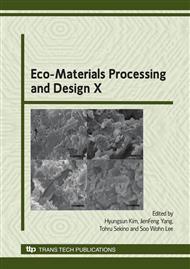p.197
p.201
p.205
p.209
p.213
p.217
p.221
p.225
p.229
Effect of Final Annealing Temperature on Antibacterial Precipitate of Copper-Bearing Ferritic Stainless Steel
Abstract:
In order to keep the steel with outstanding antibacterial characteristics, the relationship between the anneal temperatures and the amounts of the precipitated Cu-rich phase was investigated in this work. The SEM analysis of annealing specimens indicated that the microstructure changed with the increase of annealing temperature. At 900°C, the martensite phase appeared along the crystal boundary, but the amount of Cu-rich phase was almost no change. At 920°C, the sizes of the Cu-rich precipitates minished and the amounts of the precipitates reduced gradually. At 940°C, there was only martensite phase existing in the ferrite matrix. Therefore, the optimal final annealing temperature range was chosen from 880°C to 900°C to ensure attaining excellent antibacterial properties and favorable mechanical characteristic of copper-bearing stainless steel.
Info:
Periodical:
Pages:
213-216
Citation:
Online since:
April 2009
Authors:
Price:
Сopyright:
© 2009 Trans Tech Publications Ltd. All Rights Reserved
Share:
Citation:


